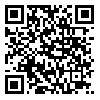Volume 10, Issue 3 (Summer-In Press 2024)
JCCNC 2024, 10(3): 0-0 |
Back to browse issues page
1- ”Community Hospital”, Local Health Authority (ASL) of Romagna, Ravenna, Italy.
2- ”San Giuseppe da Copertino” Hospital, Local Health Authority (ASL) of Lecce, Italy.
3- “Villa Adalgisa” Hospice, Ravenna, Italy.
4- Local Health Authority (ASL) of Bari, Italy.
5- Department of Mathematics and Physics "E. De Giorgi", Laboratory of Biomedical Physics and Environment, Università del Salento, Lecce, Italy. ,luana.conte@unisalento.it
6- School of Nursing, University of Bologna, Bologna, Italy
2- ”San Giuseppe da Copertino” Hospital, Local Health Authority (ASL) of Lecce, Italy.
3- “Villa Adalgisa” Hospice, Ravenna, Italy.
4- Local Health Authority (ASL) of Bari, Italy.
5- Department of Mathematics and Physics "E. De Giorgi", Laboratory of Biomedical Physics and Environment, Università del Salento, Lecce, Italy. ,
6- School of Nursing, University of Bologna, Bologna, Italy
Abstract: (400 Views)
Background: Internship represents the context for acquiring professional skills for nursing students. The bilateral relationship between the intern and the tutor, where both parties have the opportunity to grow and develop, contributes to transforming theoretical knowledge into intellectual, psychomotor, and social skills. However, the gap between education and clinical practice has always been a challenge for education experts in the field. This study aims to assess the gap between the theory learned during lectures and the applied care practice during the internship, highlighting any components opposing knowledge translation.
Methods: A prospective observational study was conducted in June and July 2022, involving
Results: A significant disparity was perceived between the learned theory and practical care in hospital setting, with 86.9% of students compared to 60.4% of tutors acknowledging this gap (p < 0.0001). In contrast to 60.4% of tutors, 87.9% of students (p < 0.0001) declared that theoretical elements were sometimes incomprehensible when applied to practice. Consequently, 78.5% of learners, as opposed to 25.0% of tutors, had to adapt their care behaviors to the methods used in the wards and services where they were on placement (p < 0.0001).
Conclusions: The study allowed for an exploration of some possible reasons underlying the dichotomy between theory and practice, both from the perspective of students and tutors. Both groups perceived the presence of a theory-practice gap, but with different implications. While tutors are willing to provide explanations, students express communicative difficulties in expressing doubts regarding the gap. Addressing the theory-practice gap, particularly during the mentoring period, could be one of the possible solutions to bridge the gap.
Methods: A prospective observational study was conducted in June and July 2022, involving
Results: A significant disparity was perceived between the learned theory and practical care in hospital setting, with 86.9% of students compared to 60.4% of tutors acknowledging this gap (p < 0.0001). In contrast to 60.4% of tutors, 87.9% of students (p < 0.0001) declared that theoretical elements were sometimes incomprehensible when applied to practice. Consequently, 78.5% of learners, as opposed to 25.0% of tutors, had to adapt their care behaviors to the methods used in the wards and services where they were on placement (p < 0.0001).
Conclusions: The study allowed for an exploration of some possible reasons underlying the dichotomy between theory and practice, both from the perspective of students and tutors. Both groups perceived the presence of a theory-practice gap, but with different implications. While tutors are willing to provide explanations, students express communicative difficulties in expressing doubts regarding the gap. Addressing the theory-practice gap, particularly during the mentoring period, could be one of the possible solutions to bridge the gap.
Keywords: Nursing students, Clinical experience, Theory-practice gap, Mentoring, Medical education
Type of Study: Research |
Subject:
General
Received: 2023/12/16 | Accepted: 2024/02/7 | Published: 2024/05/21
Received: 2023/12/16 | Accepted: 2024/02/7 | Published: 2024/05/21
| Rights and permissions | |
 |
This work is licensed under a Creative Commons Attribution-NonCommercial 4.0 International License. |


